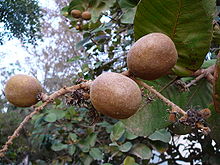Neocarya macrophylla
| Neocarya macrophylla | ||||||||||||
|---|---|---|---|---|---|---|---|---|---|---|---|---|

Inflorescence of Neocarya macrophylla |
||||||||||||
| Systematics | ||||||||||||
|
||||||||||||
| Scientific name of the genus | ||||||||||||
| Neocarya | ||||||||||||
| ( DC. ) Prance ex F. White | ||||||||||||
| Scientific name of the species | ||||||||||||
| Neocarya macrophylla | ||||||||||||
| ( Sabine ) Prance ex F. White |
Neocarya macrophylla is the only species of the plant genus Neocarya within the family of the golden plum family (Chrysobalanaceae). It occurs in the savannahs of West Africa . CommonEnglish names are "Gingerbread plum", "Ginger plum" or "Neou oil tree".
description
Vegetative characteristics
Neocarya macrophylla is a shrub or small tree that reaches an average height of 6 to 8 meters; the maximum height is 10 meters. The twisted branches sit on a short trunk. The gray bark is cracked, rough, thick and brittle.
The alternate leaves arranged on the branches are divided into a petiole and a leaf blade. The thick, hairy, brown petiole is relatively short with a length of only 3 to 7 millimeters and it has two glands . The simple, leathery leaf blade is egg-shaped to elliptical with a rounded to pointed upper end with a length of 10 to 25 centimeters and a width of 5 to 15 centimeters. The underside of the leaf is downy, hairy cobwebs. The middle nerve is covered with felt hair on both sides. The stipules fall off early.
Generative characteristics
Neocarya macrophylla flowers most of the year, but mostly in the second half of the dry season . The terminal, upright, racemose inflorescence is 30 centimeters long with tomentose hairy rachis . There are tomentose hairy front and cover leaves.
The five-fold blooms with a double flower envelope have a diameter of 12 to 20 millimeters. The cup-shaped flower cup is tomentose on the outside. The five tomentose-haired sepals are obovate. The five white to pink petals fall off early. There are up to 15 stamens and a few small staminodes. The hairy, two-chamber ovary is upper constant and is located at the top of the flower cup, it has a lateral and basal stylus with capitate scar.
The stone fruits , reminiscent of a kiwi , are ellipsoidal with a length of 4 to 5 centimeters and a diameter of 2.5 to 3.5 centimeters. They are yellowish-brown, glabrous, but with a few small, gray warts on the surface. In the yellowish, fleshy “pulp” there is a hard core with a rough, fibrous-porous shell ( endocarp ), which contains one or two ellipsoidal seeds with a thin, partly hairy tegmen . The seeds lie in a downy hairy chamber.
Occurrence
Neocarya macrophylla thrives in the coastal savannas of West Africa , such as Senegal , Gambia , Guinea , Guinea-Bissau , Liberia , Sierra Leone and the forested savannahs of southern Mali , Niger and northern Nigeria . The distribution is mostly local, although this species is very common in some places. It is grown in Panama, for example.
Neocarya macrophylla usually thrives on sandy soils .
Systematics
The first description under the Basionym Parinarium macrophyllum was made in 1824 by the English botanist Joseph Sabine in Transactions of the Horticultural Society of London , 5, page 452 and corrected to Parinari macrophylla Sabine . Ghillean Tolmie Prance presented in 1976 Bulletin du Jardin Botanique National de Belgique , Volume 46 (3-4), page 308 for this species, under the name Neocarya macrophylla , the new genus Neocarya . The basionym for this generic name is Parinari sect. Neocarya DC. the Augustin-Pyrame de Candolle in Prodromus Systematis Naturalis Regni Vegetabilis , 2, 1825, page 527 published.
Other synonyms for Neocarya macrophylla (Sabine) Prance ex F.White are: Ferolia macrophylla (Sabine) Kuntze , Parinari senegalensis Perr. ex DC. , Petrocarya macrophylla (Sabine) Steud. , Petrocarya senegalensis (Perr. Ex DC.) Steud. , Parinarium senegalense Perr.
use
Plant parts from Neocarya macrophylla have been used in traditional medicine. The pulp and the seeds are edible. An oil can also be obtained from the seeds, neou oil .
The spermatic chamber hairs can be used as tinder or medicinally.
The hard, brown wood is used as firewood and charcoal , as well as for building pirogues .
literature
- Michel Arbonnier: Trees, Shrubs and Lianas of West African Dry Zones . Margraf, Weikersheim 2004, ISBN 2-87614-579-0 , p. 251 ( Neocarya macrophylla on p. 251 in the Google book search). (Section description)
- JA Guillemin, GS Perrottet, A. Richard : Florae Senegambiae tentamen. P. 273 f, plate 61, 1830–1833, scanned into biodiversitylibrary.org .
- GT Prance, C. Sothers: B 18.2 Chryso sp plantarum. 2015, pp. 167-319, online at researchgate.net , accessed October 31, 2018.
Web links
- Neocarya macrophylla from Useful Tropical Plants , accessed October 31, 2018.
- Neocarya macrophylla . In: U. Brunken, M. Schmidt, S. Dressler, T. Janssen, A. Thiombiano, G. Zizka: West African plants - A Photo Guide. Senckenberg Research Institute, Frankfurt am Main 2008.
Individual evidence
- ^ A b c Neocarya macrophylla in the Germplasm Resources Information Network (GRIN), USDA , ARS , National Genetic Resources Program. National Germplasm Resources Laboratory, Beltsville, Maryland.
- ↑ First publication scanned at biodiversitylibrary.org .
- ^ Neocarya at Tropicos.org. Missouri Botanical Garden, St. Louis

